A Victorian cast iron and brass turret timepiece formerly installed at 'The Clock House' 8 Chelsea Embankment, London Gillett, Bland and Company, Croydon, 1880 The pierced iron ogee-outline triangular frame with plates united by pair of double-screwed pillars and a top beam enclosing brass four-wheel train with five-spoke wheel crossings, high pinion count, maintaining power and deadbeat escapement regulated by substantial wood-rod seconds pendulum with heavy cast iron cylindrical bob swinging outside the frame to the rear, the front with silvered Arabic five-minute setting dial inscribed GILLET, BLAND & Co., CROYDON numbered 7915 to verso and maintaining power lever, the rear with bevel-gear assembly and yoke for the dial take-off work, the whole mounted on original cast iron stand formed with two tall concave tapered pierced end panels joined by batons and incorporating integral movement support brackets at the rear, complete with full compliment of accessories including winding handle, line and weights (including one for the maintaining power), key for the setting hand, pulleys, motion work, lead-off rod, and an 18 inch skeletonised dial backed by translucent acrylic with hands, the movement 49cm (19.25ins) high; the movement and stand 144cm (56.75ins) high overall. The firm of Gillet, Bland and Company of Croydon can trace its roots back to the clockmaker William Gillett who moved from Hadlow, Kent, to Clerkenwell in 1837. In 1844 he relocated again, this time to Union Road, Thornton Heath, Croydon. Charles Bland became a partner in 1854, and the company subsequently traded as Gillett & Bland. In 1877, Arthur A. Johnston (c.1851-1916) bought a partnership, and shortly afterwards extended the company's output by establishing a bell foundry. The business became known as Gillett, Bland & Co until Bland's death in c.1884, when the name was changed to Gillett & Co. The name Gillett & Johnston seems to have been used from around 1887. Arthur Johnston's son, Cyril Frederick Johnston (1884-1950), joined the company in 1902, became a partner in 1907, and took over the firm following his father's death in 1916. He developed an interest in the theory of bell tuning, and greatly expanded the bellfounding side of the business. During the First World War, the factory suspended its regular business and became involved in the manufacture of munitions, employing over 1,250 men and women. The firm became a limited liability company in 1925, initially trading as the Croydon Bell Foundry Ltd (although the name Gillett and Johnston still appeared on bells). It reverted to the name Gillett & Johnston Ltd in 1930. After going into receivership in 1857 the company was subsequently re-established and still trades today as clockmakers specialising in the maintenance and restoration of turret clocks. The Gillet Bland and Company day ledger records the installation of the current lot at the Clock House, 8 Chelsea Embankment on the 10th March 1880. These records indicate timepiece was supplied with two 3ft. 6in. diameter copper dials with Arabic numerals at a cost of £55. The house was designed by the celebrated Victorian architect Norman Shaw and the clock was positioned inside the house driving a pair of dials set on a large projecting iron bracket attached to the façade. The current mechanism was removed and substituted for an electric movement whilst the building was being converted into flats during the 1980's.
A Victorian cast iron and brass turret timepiece formerly installed at 'The Clock House' 8 Chelsea Embankment, London Gillett, Bland and Company, Croydon, 1880 The pierced iron ogee-outline triangular frame with plates united by pair of double-screwed pillars and a top beam enclosing brass four-wheel train with five-spoke wheel crossings, high pinion count, maintaining power and deadbeat escapement regulated by substantial wood-rod seconds pendulum with heavy cast iron cylindrical bob swinging outside the frame to the rear, the front with silvered Arabic five-minute setting dial inscribed GILLET, BLAND & Co., CROYDON numbered 7915 to verso and maintaining power lever, the rear with bevel-gear assembly and yoke for the dial take-off work, the whole mounted on original cast iron stand formed with two tall concave tapered pierced end panels joined by batons and incorporating integral movement support brackets at the rear, complete with full compliment of accessories including winding handle, line and weights (including one for the maintaining power), key for the setting hand, pulleys, motion work, lead-off rod, and an 18 inch skeletonised dial backed by translucent acrylic with hands, the movement 49cm (19.25ins) high; the movement and stand 144cm (56.75ins) high overall. The firm of Gillet, Bland and Company of Croydon can trace its roots back to the clockmaker William Gillett who moved from Hadlow, Kent, to Clerkenwell in 1837. In 1844 he relocated again, this time to Union Road, Thornton Heath, Croydon. Charles Bland became a partner in 1854, and the company subsequently traded as Gillett & Bland. In 1877, Arthur A. Johnston (c.1851-1916) bought a partnership, and shortly afterwards extended the company's output by establishing a bell foundry. The business became known as Gillett, Bland & Co until Bland's death in c.1884, when the name was changed to Gillett & Co. The name Gillett & Johnston seems to have been used from around 1887. Arthur Johnston's son, Cyril Frederick Johnston (1884-1950), joined the company in 1902, became a partner in 1907, and took over the firm following his father's death in 1916. He developed an interest in the theory of bell tuning, and greatly expanded the bellfounding side of the business. During the First World War, the factory suspended its regular business and became involved in the manufacture of munitions, employing over 1,250 men and women. The firm became a limited liability company in 1925, initially trading as the Croydon Bell Foundry Ltd (although the name Gillett and Johnston still appeared on bells). It reverted to the name Gillett & Johnston Ltd in 1930. After going into receivership in 1857 the company was subsequently re-established and still trades today as clockmakers specialising in the maintenance and restoration of turret clocks. The Gillet Bland and Company day ledger records the installation of the current lot at the Clock House, 8 Chelsea Embankment on the 10th March 1880. These records indicate timepiece was supplied with two 3ft. 6in. diameter copper dials with Arabic numerals at a cost of £55. The house was designed by the celebrated Victorian architect Norman Shaw and the clock was positioned inside the house driving a pair of dials set on a large projecting iron bracket attached to the façade. The current mechanism was removed and substituted for an electric movement whilst the building was being converted into flats during the 1980's.


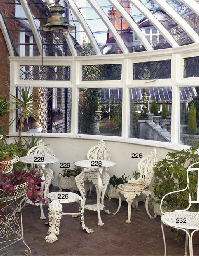


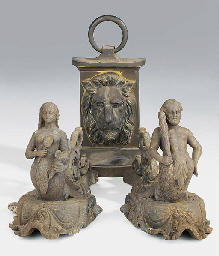
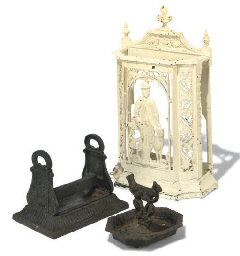



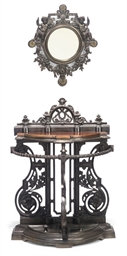


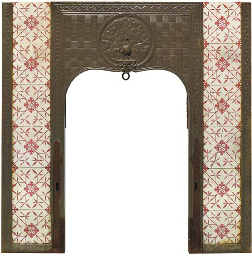
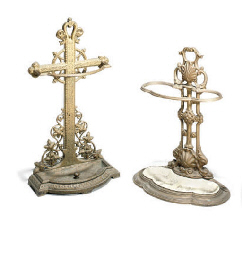
Try LotSearch and its premium features for 7 days - without any costs!
Be notified automatically about new items in upcoming auctions.
Create an alert